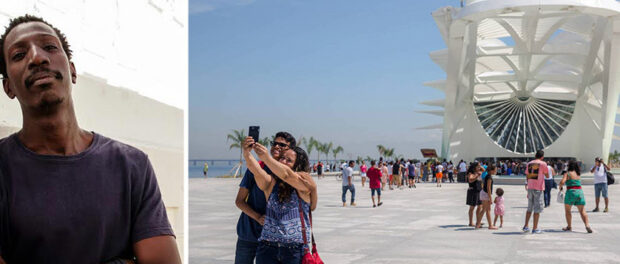
The original text was published in Portuguese by researcher Ronilso Pacheco* on his Facebook page and republished by Favela 247. Ronilso works with the NGO Viva Rio and is a consultant for social movements and human rights organizations.
Perhaps this post is unnecessary. Perhaps. But nonetheless I choose to share my disenchantment, my frustration, because everything about the building of the Museum of Tomorrow (not necessarily the museum itself), and what it represents, disturbs me.
It affects my memory to know that the museum was built on a macabre piece of land: the port of entry for the largest contingent of black slaves in the history of humankind. Traded like merchandise, they were either sold, or became human garbage, or they died. The Valongo (slave wharf) area in the Port Region contains the remains of more slaves than any other place in the Americas. Did you know that? More than 500,000 of the men and women who came here as slaves entered through Valongo, where the Museum of Tomorrow stands. Their bodies are down there, buried in the ground or thrown out to sea. The business of selling black men and women was transferred to Valongo from what is now Praça XV, to ensure that those in the downtown area would not have to endure the presence of such ugly, dirty people; so that their odor wouldn’t upset the atmosphere and aesthetic of the city, which was eager for its urban design to inspire comparisons to Paris.
It disturbs my own history, and my historical consciousness, to know that a black past is deliberately ignored and destroyed so that a white middle class future can be erected in its place with celebration and pageantry. Could anyone imagine building a Museum of Tomorrow at Auschwitz? Never. On the contrary, in Germany, all students must (I said “must”–it’s required) visit at least two concentration camps at some time during their schooling. It’s an important ritual. They must never forget that there people were treated as if they were worth nothing. But in Rio, the construction of the Museum of Tomorrow represents an affirmation that if the past is black, “it’s of no interest to us.” That there’s nothing worth preserving. Just leave those forgotten bodies, like garbage decomposing in a landfill. Give them a few plaques, folk art exhibitions, parties.
And so we have the Museum of Tomorrow. Truly beautiful to look at. Truly impressive. And I would even be tempted to visit, if it weren’t for this pain, this indignation; the deafening silent cry of those who died with nothing.
*Ronilso Pacheco is a representative of the NGO Viva Rio, theology student at PUC-Rio, member of the Coletivo Nuvem Negra (Black Cloud Collective)–a black student group at PUC-Rio, and consultant to social movements and human rights organizations.
